Today we give continuity to our review of Brazilian prototypes, this time with a project born in the 2000’s to face imported models which then dominated local endurance racing. However, before we delve into the technical details, let’s know the path that led to the GT R1, and how this car is linked to the Fiat Endurance racing team, a Brazilian prototype from the 70’s, “The King” of Brazilian Musisc Roberto Carlos and a Chevrolet dealership chain.
GT Race Cars: a short history
As the title obviously give away, the GeeBee R1 was developed by GT Racecars (GT coming from Gulinelli Técnica), a company located in Campinas and led by engineer Jaime Gulinelli. The car itself was developed with the help of fellow engineers Rafael Diniz Santiago, Luis Guilherme Lauzi Gozzani and Reinaldo Araújo.

Initially, GT Racecars supplied electronic fuel injection support to the Brazilian Formula 3 Championship and track support for Fiat’s Endurance Racing Team, at the time running two Fiat Brava and one Marea Weekend Turbo. Lately, the company also supplied the same services for Ancona’s Racing team VW New Beetle and for the Chevy Montana pick-up trucks from GM’s factory racing team.
GT R1 development
The GT R1 project was born from the will of entrepreneurs Dimas de Melo Pimenta II and III, from DIMEP (Dimas de Melo Pimenta Sistemas de Ponte de Acesso). The goal was to use the know how developed by GT Racecars in previous projects to conceive a prototype with modern chassis design and aero, while retaining the Chevrolet V8 Quadrijet and Hewland DG300 5-speed transaxle from the Avallone A11 prototype owned by the Pimenta family. To give some context, this same car went to score the pole-position at the 1993 Brazilian Mille Miglia, and previously used by Pedro Victor Delamare in the Divisão 4, then using a Chevy 250-S 6 cylinder engine).
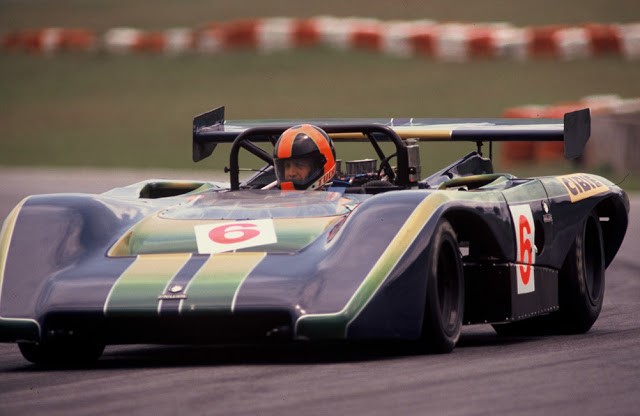
The plan was that the combination of a modern chassis with a classic Powertrain could be a match for the cars competing at Brazilian Endurance races, aiming for a lap time around 1m37s at Interlagos.
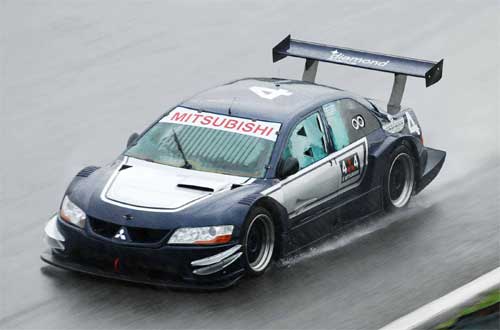
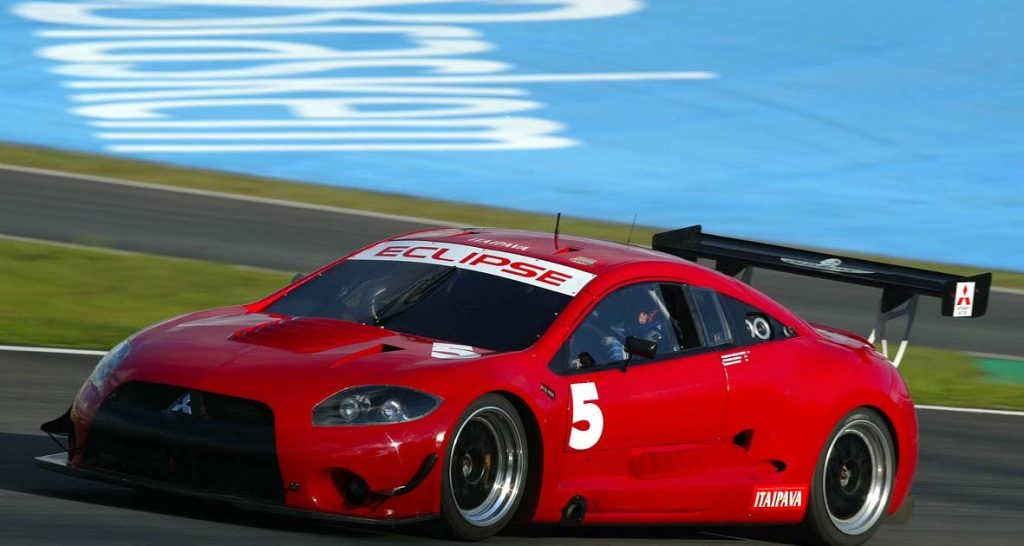
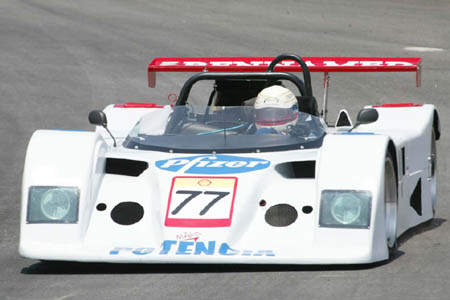
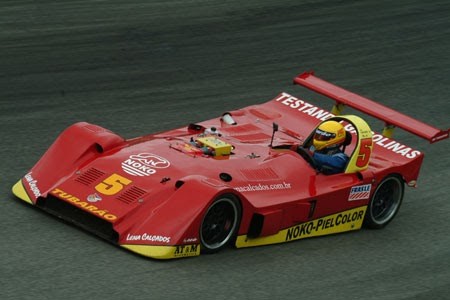
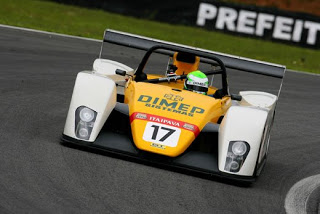
Development started by end 2004, looking to debut at 2005, and besides engineers Rafael Santiago, Luis Guilherme Gozzani and Reinaldo Araújo, the project also had the consultancy of the late Ricardo Divila. The first shakedown happened at Interlagos in June 2005, followed by another test at Goodyear proving grounds in August, plus other test session at Interlagos in October the same year.
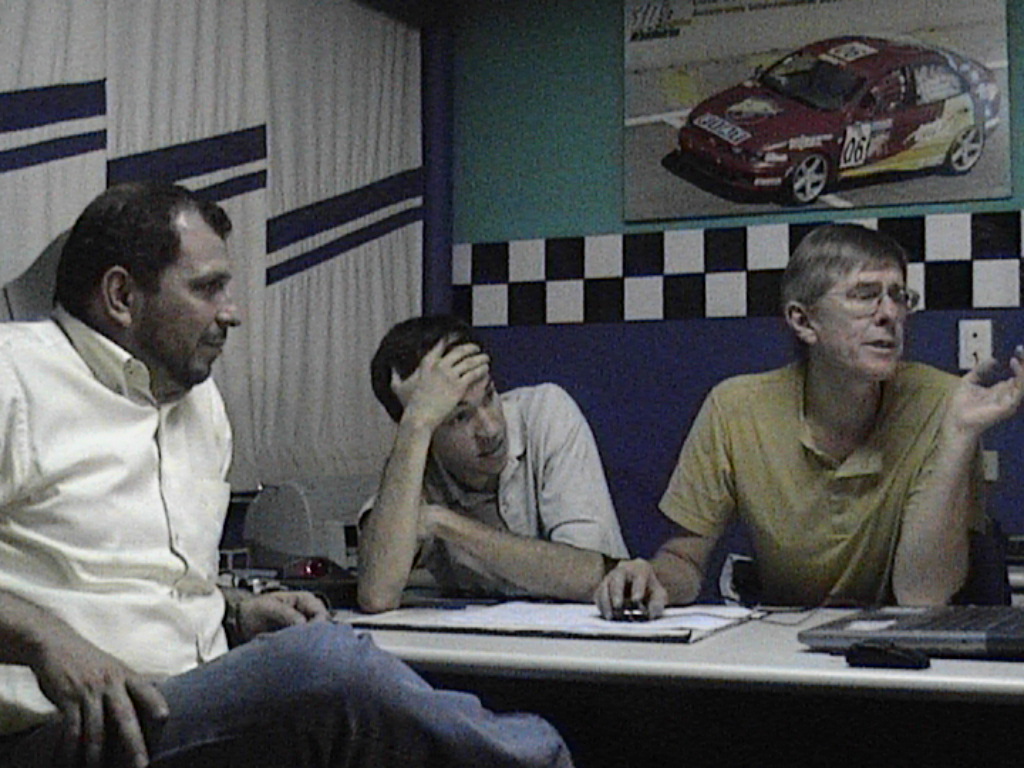
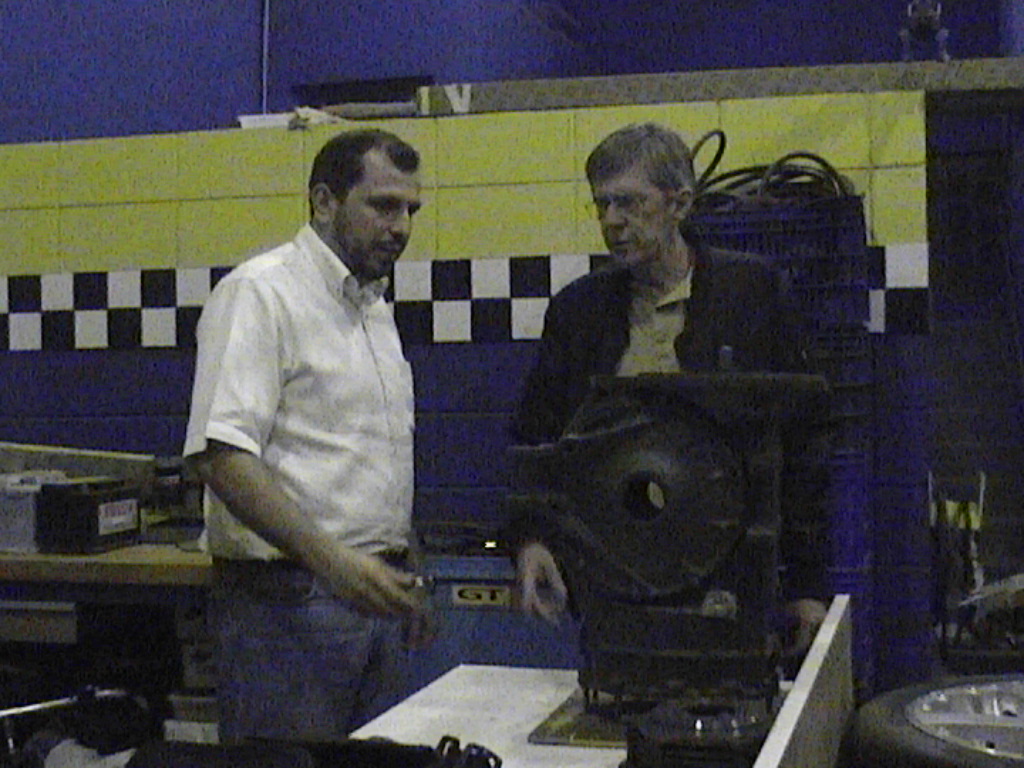
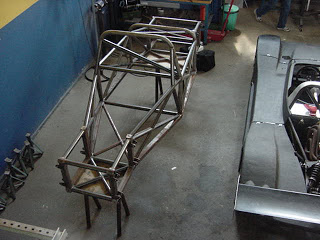
Initial tests highlighted some small issues, like a stuck clutch pedal due to some gaps at the actuator cylinder, plus some cooling issues due to a bad connection between the two radiators, and higher than expected cooling fluid temperature, solved with adjustments to the air intakes. For these initial runs lap times were around 1m50s, mainly due to power being limited by the carburetor running only with the first stage open. However, as the old engine started to show more and more issues, the Pimenta family lost some of its momentum, freezing the development until the program was reactivated in 2008, when the official race debut was planned for that year’s Mille Miglia.

 Jorge Sá.
Jorge Sá.With the engine still limited to 520 HP, the car got the second place at qualifying, with a time of 1m36s999 (until the, the best for a Brazilian project at Interlagos). During the practice sessions, the tires, a carry-over from Brazilian Stock Cars, were unable to handle the loads the prototype could produce, to the point of a failure destroying the rear bodywork, leading to a partial rebuild in the night between qualy and the race. On race day the car was ready, but, during the race the main fear of the team materialized, as the ancient transmission broke down after only a few laps, when they were battling for the lead against the Porsche 911 GT3 RSR from Marcel Visconte, Max Wilson and Raul Boesel.
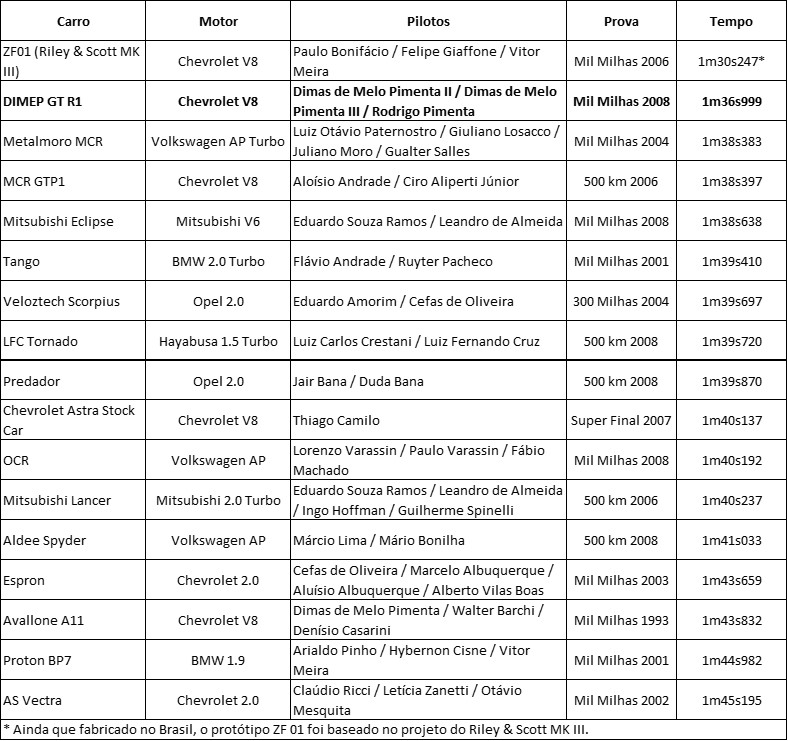
After confirming the car’s potential, a series of updates began to be implemented to the GT R1. First, the Hewland gearbox was replaced by a Xtrac 6-speed sequential, able to handle the V8 grunt. Also, the car received new center nut 18” Oz wheels, with a 11” of width at the front, and 13” at the rear with 285 tires at the front and 305 rears. Also, the bodywork was modified seeking more front downforce. With all these improvements, track testing was conducted at the fourth and seventh rounds of the 2010 São Paulo Formula Libre Championship.
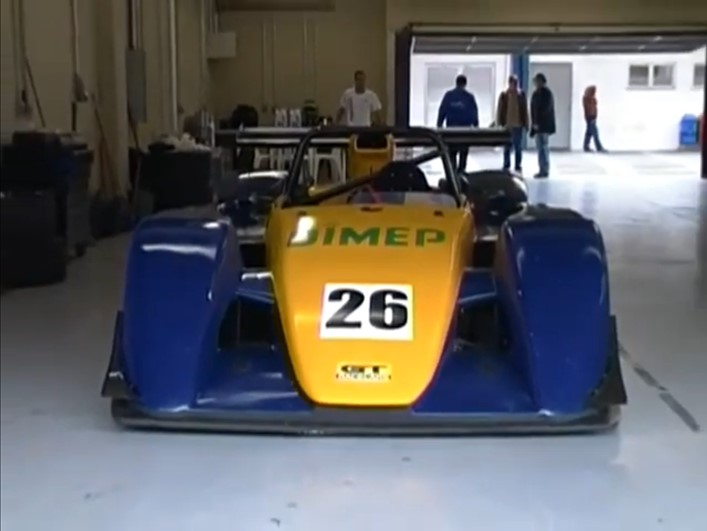
For 2011, a new front end was designed, inspired by contemporary LMP1 prototypes. Again the Formula Libre races were selected to conduct testing, with the car achieving times around 1m35s5, even if the power was still limited to preserve the half shafts.

 Rodrigo Ruiz.
Rodrigo Ruiz.The 2012 Season marked the GT R1 return to national level races, when the DIMEP team choose to participate in the Top Series, a championship mixing GTs and prototypes seeking to ressurect the Brazilian Endurance Championship. Running in the Top 1 PR class, the car showed its strength with three class pole-positions and one class win in the four rounds organized by Auto+.
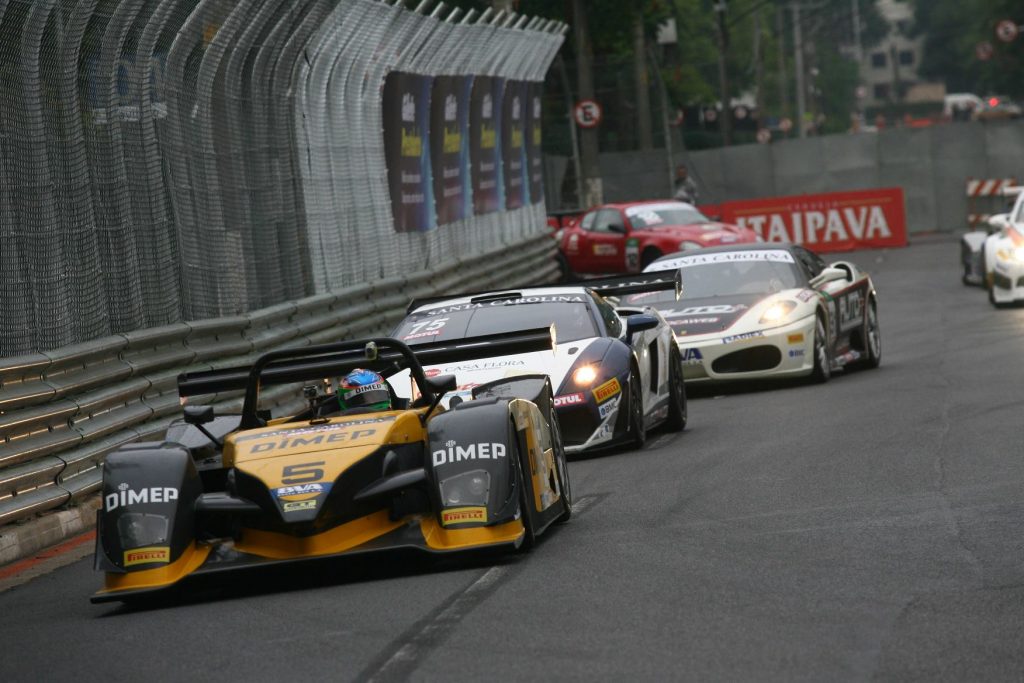
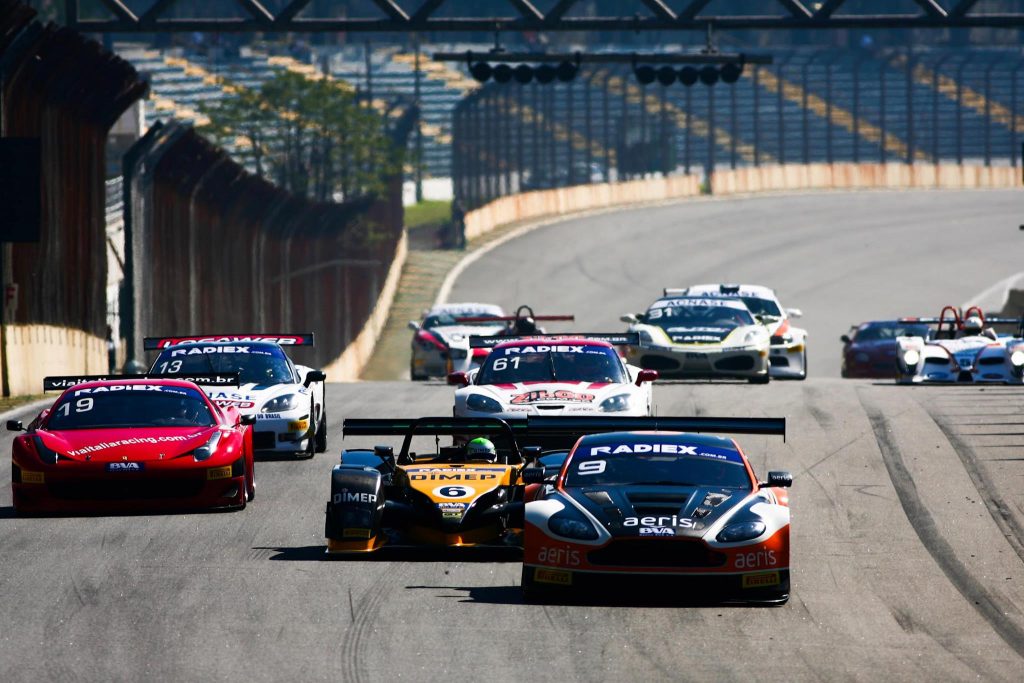
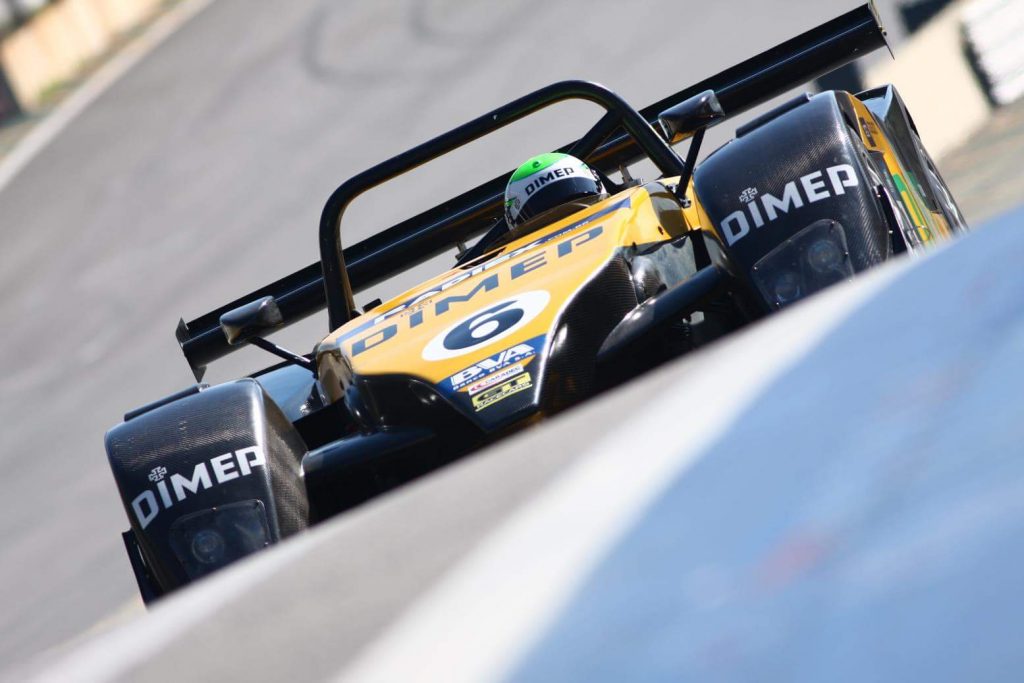
The GT R1 would returno to Interlagos once again in 2013, for the 6 Hours of Interlagos WEC round. However, this time it would not be challenging for victories, as the car was not suited for any of the FIA classes, and instead was the car chosen by Emerson Fittipaldi to be part of the event’s promotional activities.
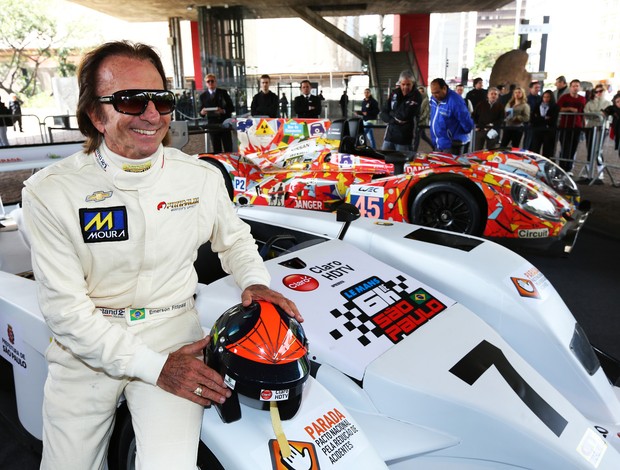
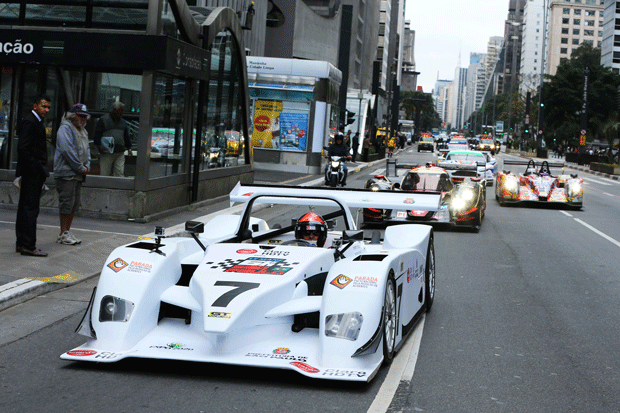
Always driven by Emerson, the car was used to a series of activities like a parade around São Paulo streets together with some WEC racers, and a series of demo laps between the practice sessions. Also, some demo laps were run with Roberto Carlos, a singer known as “The King” in Brazil, as shown by TV show Fantástico:
https://globoplay.globo.com/v/2781382/
For the events, the car was painted white (according to Roberto’s superstition of preferring the colors white and blue), and a second seat was adapted so Emerson could take some guests for demo laps around Interlagos, as well as to accompany Roberto during his driving session.
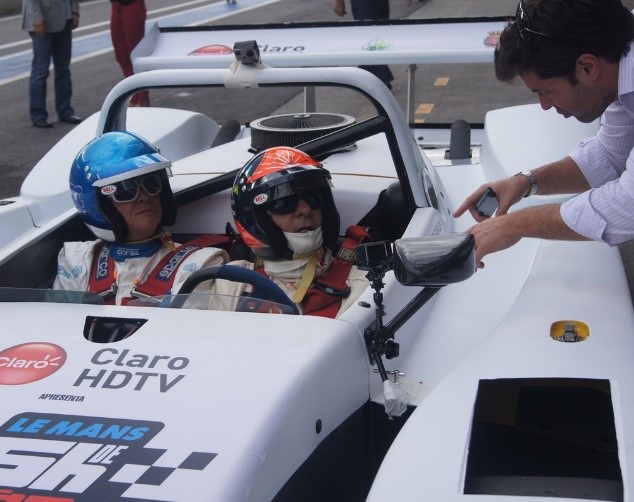
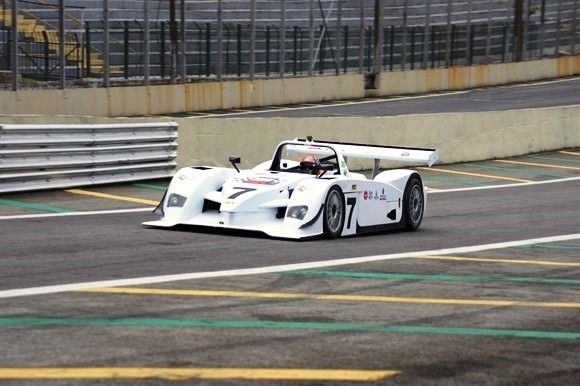
According to Jaime Gulinelli, the GT R1 was selected by Emerson after knowing the technical capabilities of the car, both on performance and safety. Below, a translation of a press realese from the event:
“We did the whole project, from drawing, through building and development, all in Brazil and strictly following the FIA Annex J recommendations.” tells engineer Jaime Gulinelli, responsible by the car. “It was genuinely conceived for endurance racing, and we are really happy for it to be selected for the promotion of the 6 Hours of São Paulo due to it’s performance and safety capabilities”.
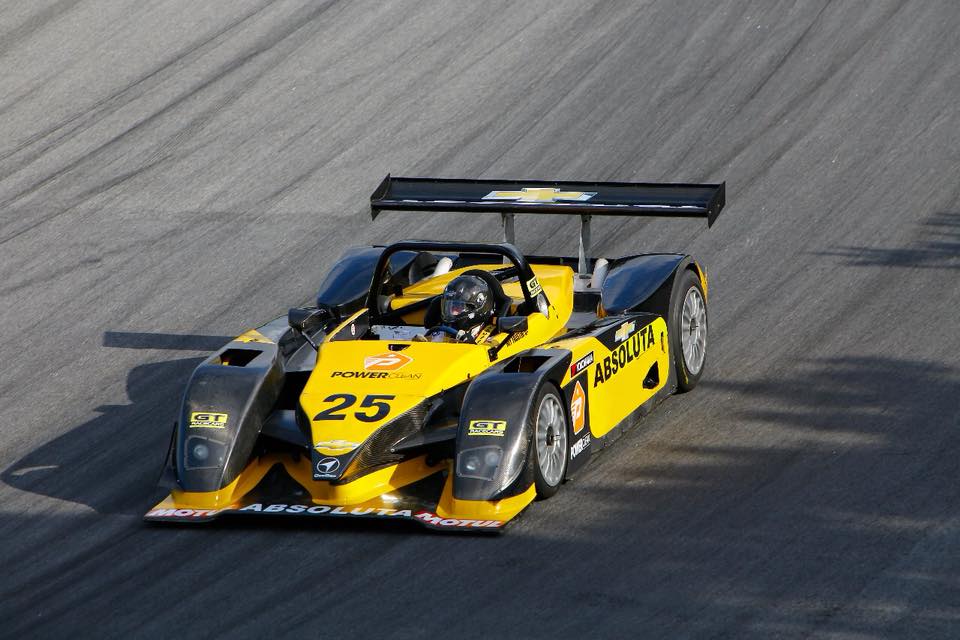
After the 2013 exhibition, the DIMEP GT R1 went to a temporary retirement as endurance racing in Brazil was living a low phase until things started to change with the growth of Endurance Brasil. This way, one more time the GT R1 would be called to action, but this time driven by Ney Faustini, owner of the Chevrolet Absoluta dealership chain, and a race driver with passages in many Brazilian categories like Divisão 3, Divisão 4, Turismo 5000 and Stock Car. Also, due to this new link the car’s name was changed to GeeBee, per suggestion of the manufacturer. This new name is a stylization of the initials GB, from Gulinelli – Bromberg, owners of GT Racecars. Ney’s first contact with the new car happened during the second double header of the Campeonato Paulista de Força Livre, which was used by the Absoluta Racing Team as a shakedown for the car that was stored by nearly 5 years. The team would also participate in the third round of the Força Livre championship as a practice, but the real goal was to debut in the Endurance Brasil Series.
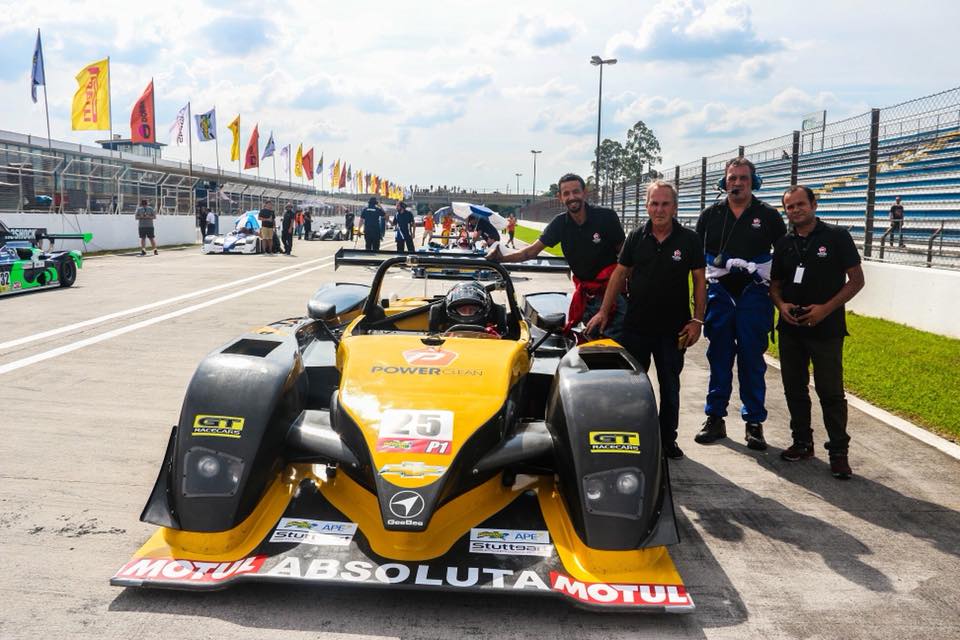
This new debut happened at the 4 Hours of Curitiba, the 2018 Endurance Brasil season opener. Even if the GT R1 was the fastest Brazilian made car in 2008, 10 years meant that the car would be facing a new generation of competitors, mainly the AJR prototypes from Metalmoro / JLM Racing. The disadvantage versus the newer cars was evident, and made even worse due to the relative low power output from the small block Chevy 350 V8.
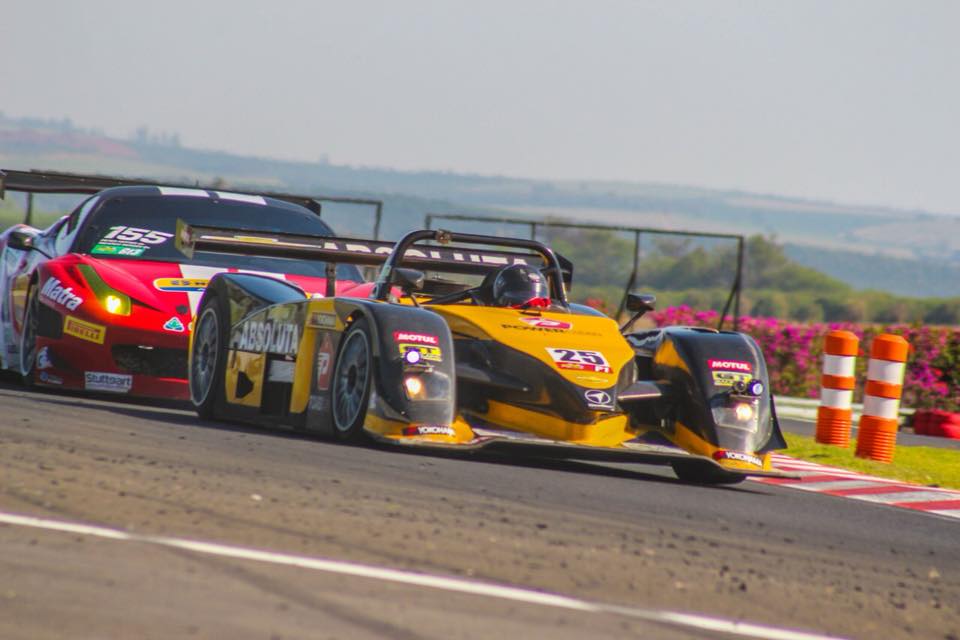
Starting from the Velocittà round, the fourth of the season, the engine was replaced by another GM unit, this time a 406 V8 prepared by Sylvio Luongo. With a LS Dart iron block and Dart Pro 1 heads, this engine delivered 650 HP and 82 kgf.m of torque.
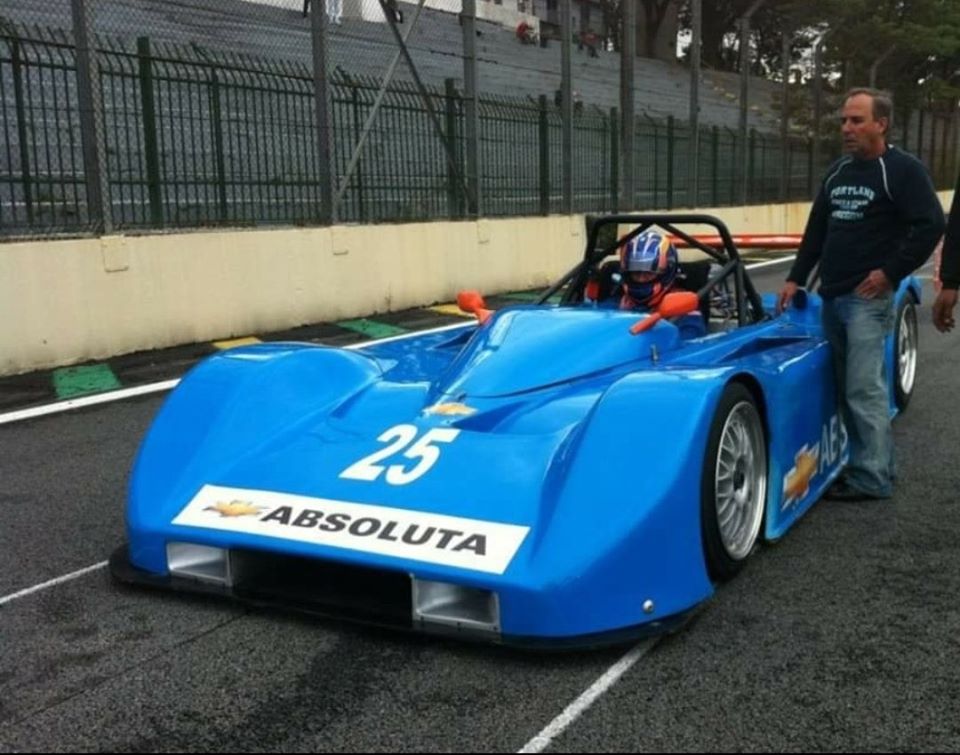
In addition to the 406 V8, the team also had at its disposal a Chevy 427 V8 with nearly 700 HP. This engine, which originally equipped the Alfran 450A, another prototype in owned by Absoluta Racing, brought new life into the old car, scoring two third place finishes in the P1 class in the Velocittà round and at the season finale in Tarumã.

For 2019, the technical regulations split the former P1 class in two: P1 would be the category for modern prototypes (AJR, Ginetta G57, Sigma P1 and DTR01) and P2 would be the class for older designs (MRX, MCR Grand Am, Predador, Scorpion, Tubarão IX and the GeeBee). The good performance obtained in the last rounds of 2018 were an indication that the new season would be a success, which was confirmed with two consecutive wins at Curitiba and Goiânia.
The Goiânia round also was stage of a scene that, even being sad due to the financial loss, was a reminder of the golden age of F1. About one hour and a half in the race the 427 engine blew up leaving an enormous cloud of white smoke, forcing the team to return to the 406 V8 engine for the remaining of the season.
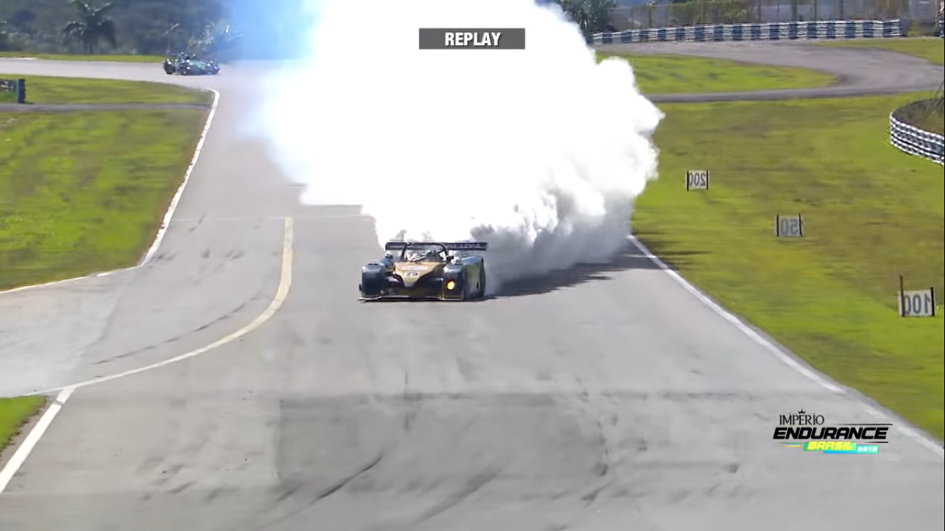
The wheels of fortune have changed for the Absoluta team, as two retirements at Santa Cruz do Sul and Velopark left the squad sitting while rivals Mauro Kern and Paulo Sousa built a considerable advantage in the points table.
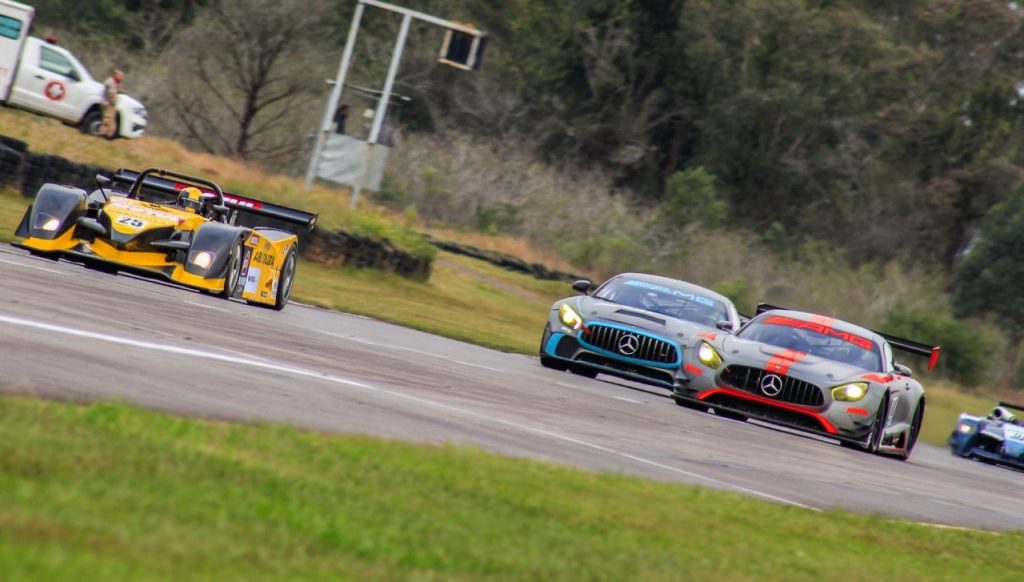
For the fifth round the son and father duo obtained a fourth place finish in class, however at this point the gap to the Tubarão IX squad was already far too great to recover, and hence the team choose not to run the final rounds. The last time the GeeBee R1 would see action would be in a regional Formula Libre race organized by LDA, where Ney Faustini obtained the pole-position and two overall wins.
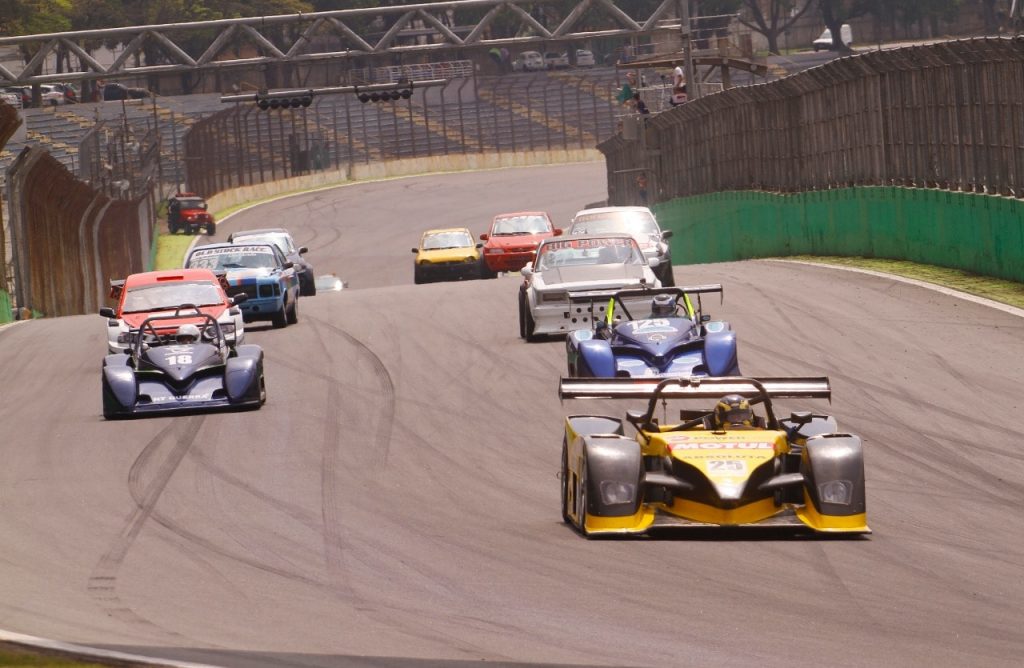
Ever since the prototype returned to the Pimenta family, while Absoluta Racing team focused its efforts to bring the Alfran 450A prototype up to date for the 2021 Endurance Brasil season.
Technical Analysis
Part 1 – Chassis
The GeeBee chassis is a 4130 steel tubeframe, fully developed with CAD and following the guidelines from Articles 258A (Sports Racing Cars) and 259 (Production Sports Car – Group CN) of the FIA Annex J. The project focuses on safety, with a 6 point rollbar and carbon fiber crash boxes at both ends (a first for Brazilian built cars).

Suspension design is double-A on all corners, with push rods, rockers and Koni shock absorbers. Front end bodywork has a cover to facilitate access to adjust the shocks and other systems.
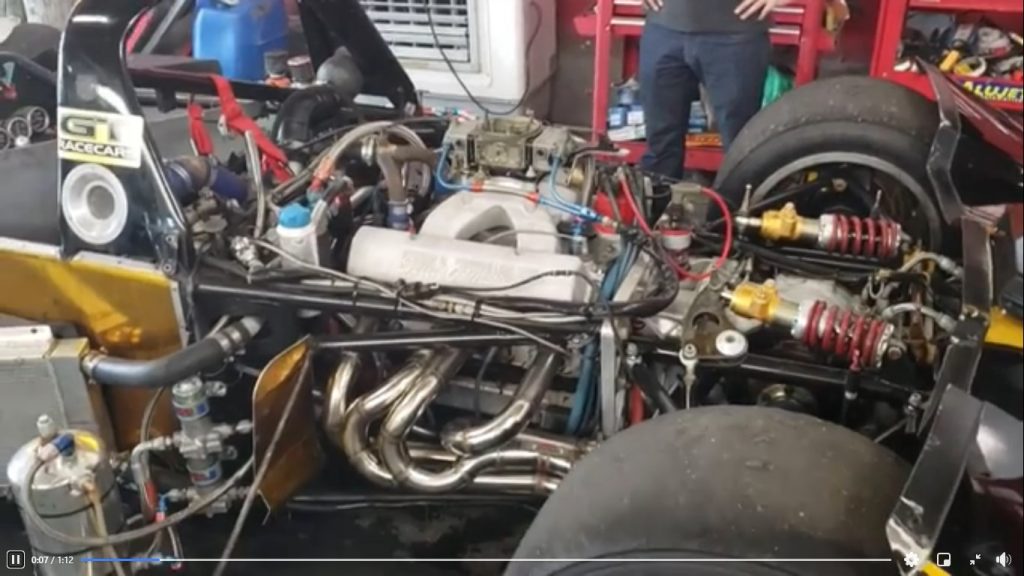
Initially, the GT R1 used 18” wheels similar in size to those used in Brazilian Stock Cars, with 285/645 tires all around. Ventilated discs are present on all 4 wheels, with 6 piston calipers at the front and 4 piston calipers at the rear. In the 2009 update, the wheels were replaced by Oz center nut units (the first version used 5 nut wheels, similar to a road car) and the rear tires were enlarged to 305.
From the beginning, there is hydraulic power steering, and the suspension was fully redesigned with the new wheel set up.
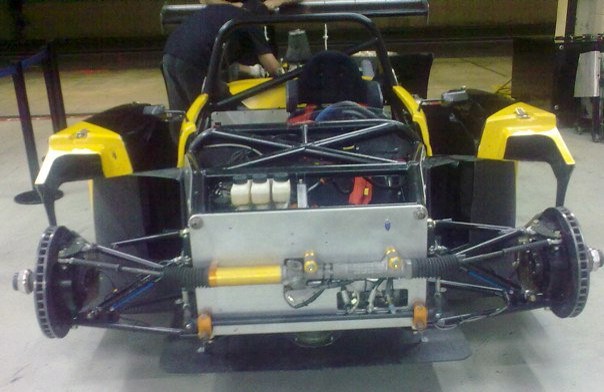
Bodywork employs a mix of carbon and glass fiber, to a total weight of 970 kg.
Part 2 – Powertrain
As already mentioned, the GT R1 initially received the Powertrain from the Avallone prototype in which the Pimenta Family competed at the 1993 Millle Miglia. The engine was an old school carbureted Chevy 350 V8, with a cast iron block mated to a Hewland DG300 5 speed manual transmission, a versatile project that equipped a vast array of cars in the 70’s, from F1 and F5000 single seaters to Le Mans and Can-Am prototypes.

The old gearbox actually was the Achilles’ heel for the R1, and by 2009 it had already been replaced by a 6 speed sequential Xtrac P386D, the same originally developed for the Daytona Prototypes and that found its way also in the JL-G09 Brazilian Stock Cars.

Speaking of engine, while at the hands of the DIMEP team there was also the option to use the larger Chevy 406 V8 from the Corvette used by Dimas Pimenta to run in editions of the some Mille Miglia and for Mile Speed Race Events. With a Holley carburator, this engine achieved a maximum power output of 730 HP, as tested by Racing Magazine, and has even being installed in the GT R1, albeit limited to circa 520 HP to protect the transmission and driveline components.
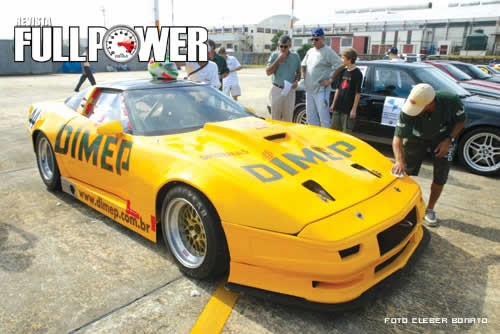
Then, when raced by Absoluta the car received a third engine option, this time a Chevy 427 V8 with a Dart aluminum block and Brodix heads, with a max power of 700 HP and 87 kgf.m torque, and also a lower weight when compared to the 350 / 406 cast iron blocks. This new engine allowed for a performance boost, helping the team achieve two third in class finishes later in the 2018 season.
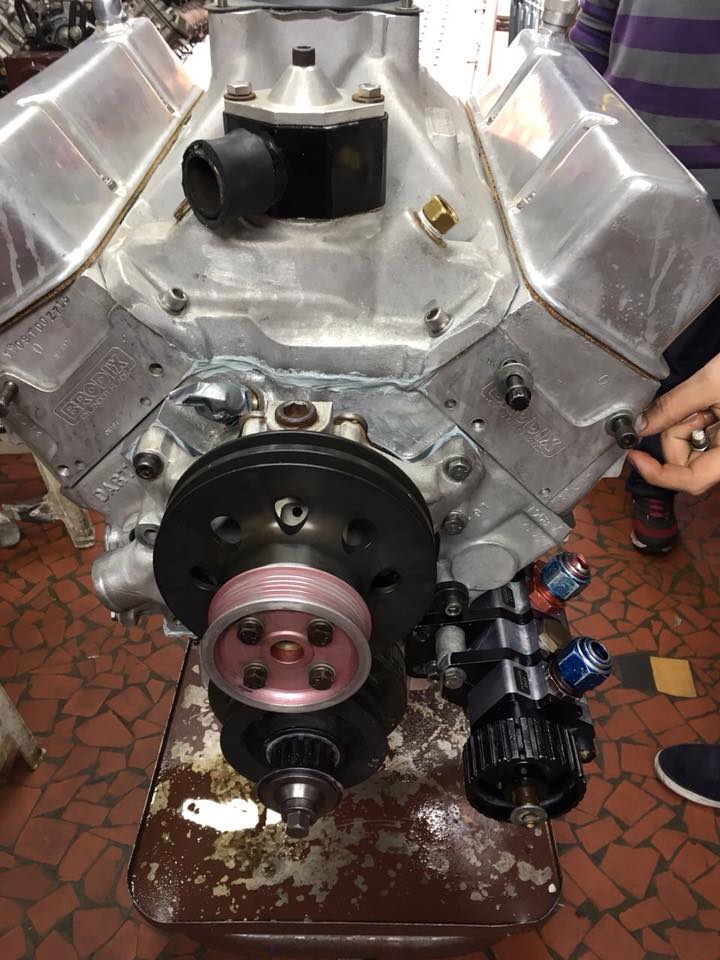
Part 3 – Aerodynamics
The first gen GT R1 aero concept is clearly inspired on contemporary LMP1 cars, mainly the almighty Audi R8 LMP.

At the front end we can spot a small splitter (1), and the ducts (2) contouring the nose lead air to the side mounted radiator inlets (3).
Also, we can see the front diffuser (4), that produces a large chunk of the front downforce.

Looking at the side view, we can see that the wheel well vent merge with the diffuser outlet via two side exhausts (5). We also can spot a central air scoop, similar to NA engine prototypes from the 90’s, like Ferrari 333 SP and Riley&Scott MK III (6). We also can see the rear wheel arches sculpted in a pontoon shape, a trend started in 1999 with the BMW V12 LMR, and followed by many ever since. Last, the rear wing is a single element design with a gurney flap on top and sideplates connecting to the bodywork, a trend started with the Audi R8 in 2001.
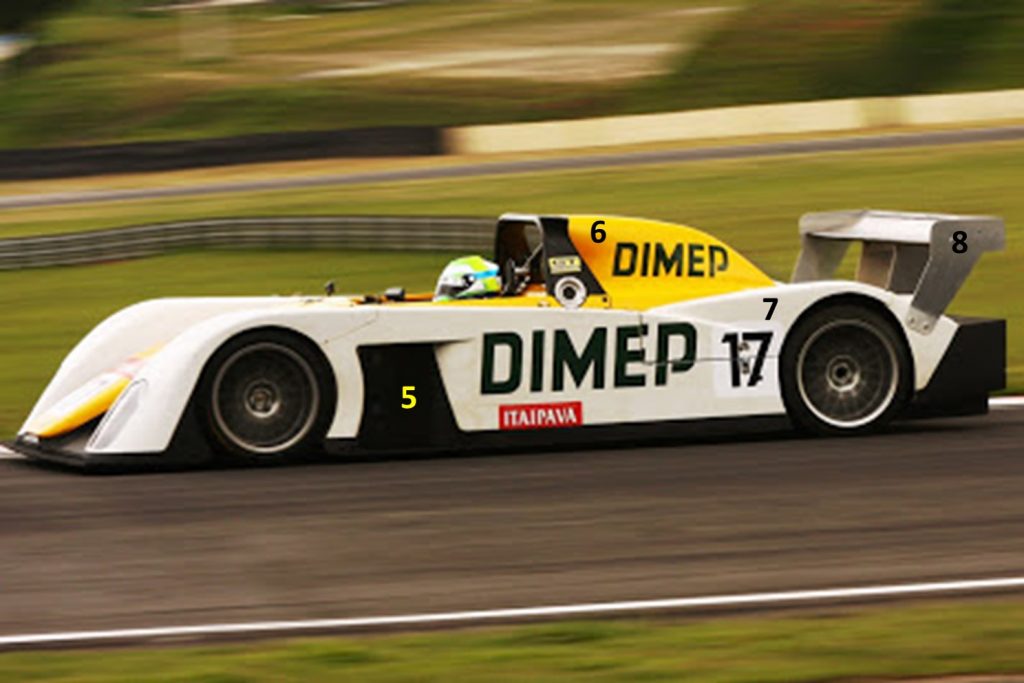
For 2010, many updates were implemented to the GT R1. Besides the mechanical updates, the front end was modified to improve downforce, with the addition of two canards (9) and louvres (11) to vent the wheel arches. A small windshield was implemented (12), possibly to improve comfort to the drivers, and we can also see the front brakes air inlets (10), not visible with the black paintjob used at the 2008 Mille Miglia.
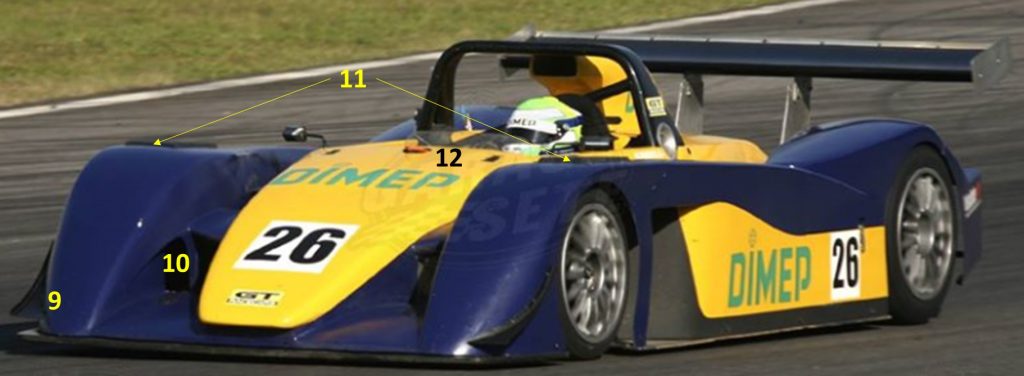
This configuration ran between 2010 and 2011 at regional sprint events, until a new configuration debuted for the 2012 season. The main changes occurred again in the front end, with a new design clearly inspired by LMP1 from that time, like Audi R10 TDI and Acura ARX02-a. The first big evolution was the nose (13), now sitting much higher to allow a better air intake to the upper face of the front splitter (14). This is also a new design, projecting much further than the previous iteration and increasing surface area where downforce can be generated. This splitter has a wing profile to it (15), also improving its effect. When debuted in daytime sprint races, this configuration was missing the headlights, and still kept the carbon air intake.
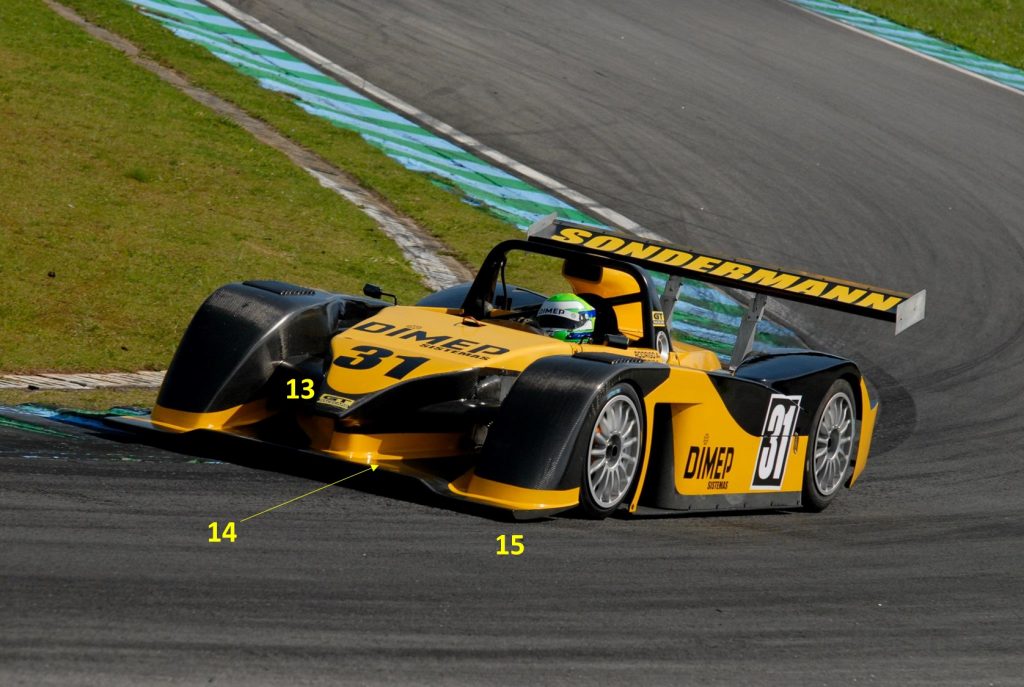
Besides the aero update, the new front end was designed to simplify access to the inner mechanics of the front section, inspired by the concept used on the Peugeot 908 HDi. For that, the chassis frontal section got a redesign, and the new front end now integrated the splitter, fenders and crash box in a single piece, made from 9 different parts bonded together and fixed to the chassis by four points (two screws and two locks).
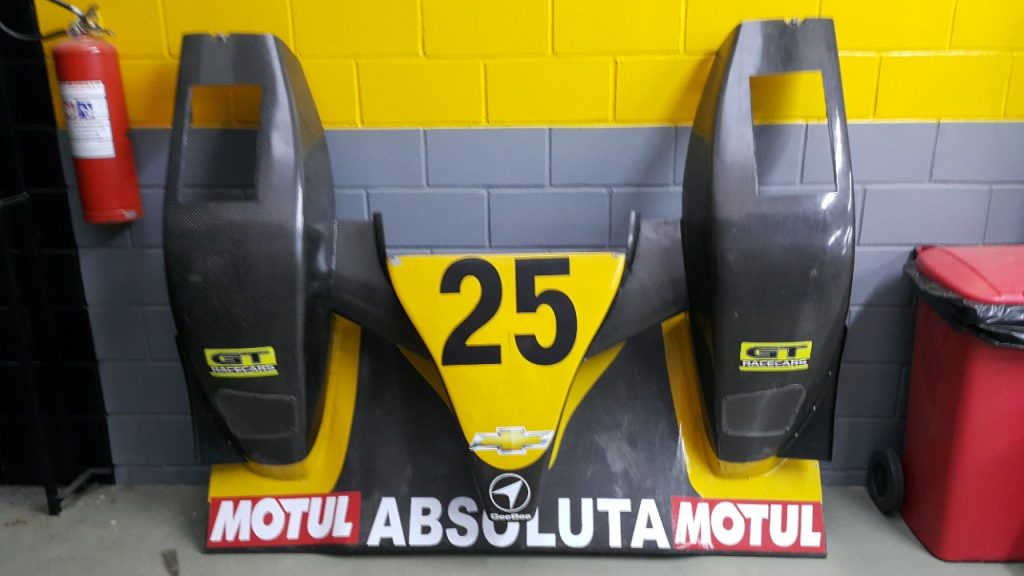
After this shakedown, the car had its real debuta t the first round of the Top Series championship, with a few updates. First, the headlights were installed (14), a necessity for endurance racing, and also two canards (15) were added in the never ending struggle for front downforce. Side wise, NACA ducts (16) were added to redirect air to the rear brakes, and the rear view mirrors got replaced by larger units improving rear visibility. Below, we can also see that the front fenders became a pontoon design, better isolating pressure generated by the tires movement from the air flow coming from the splitter/diffuser section (18). Another big difference is the complete absence of the air intake, with the air filter facing the air directly (19).
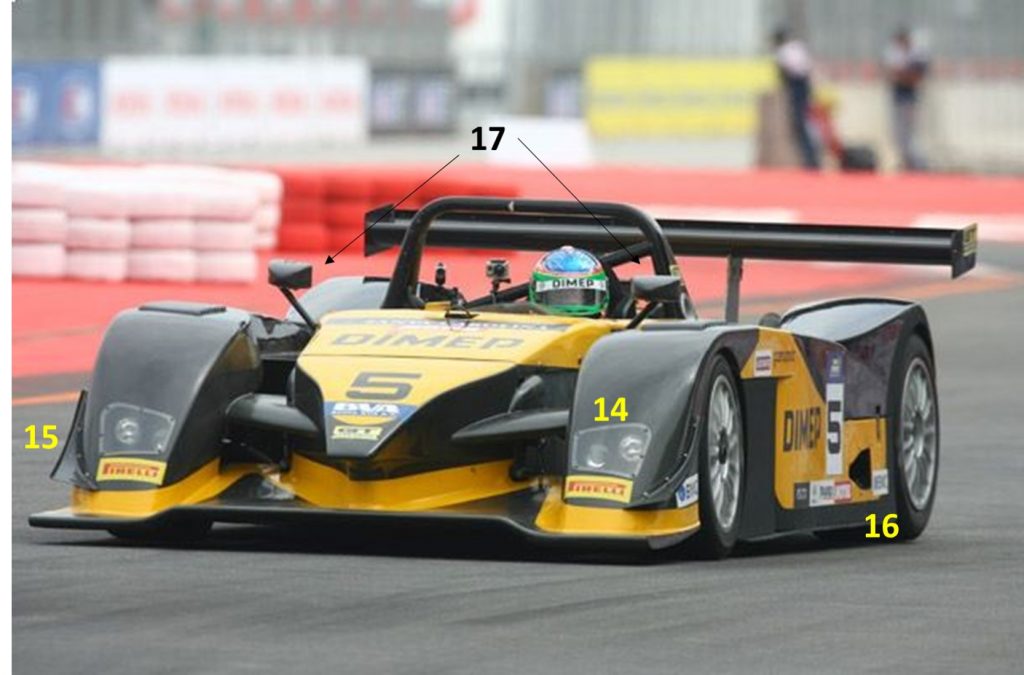
Also, the right sidepod received an additional radiator inlet (20), improving air flow and heat rejection.
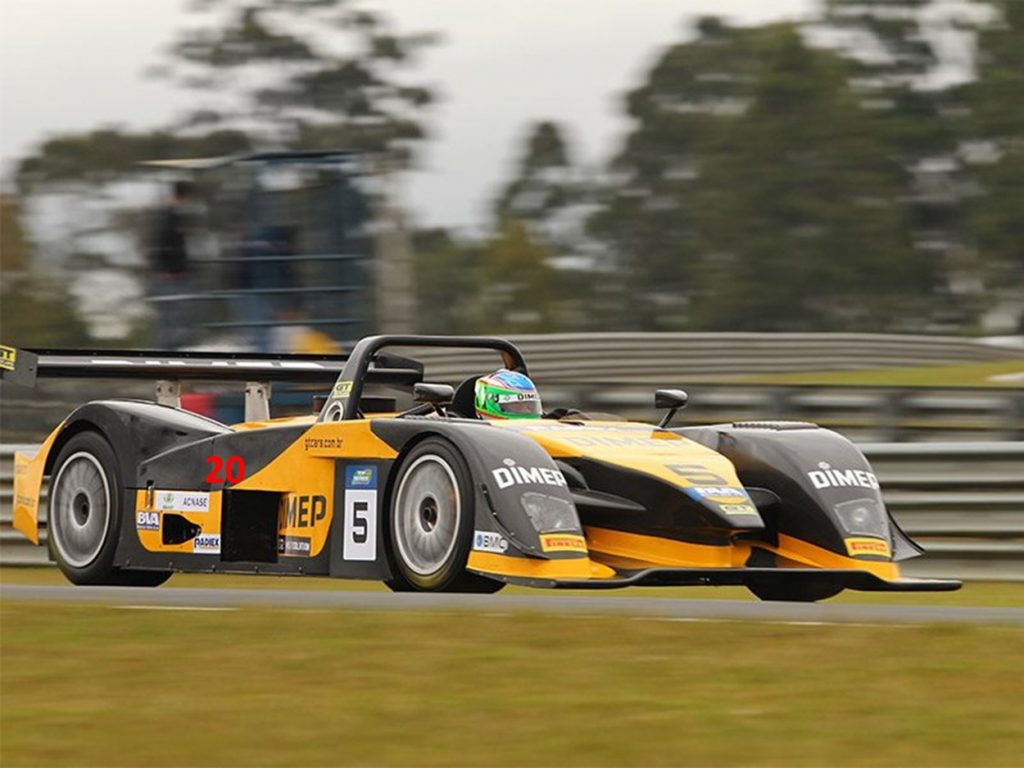
Rearwards, we can see the diffuser (21) and two gurneys, one at the rear wing and other over the rear deck (22).
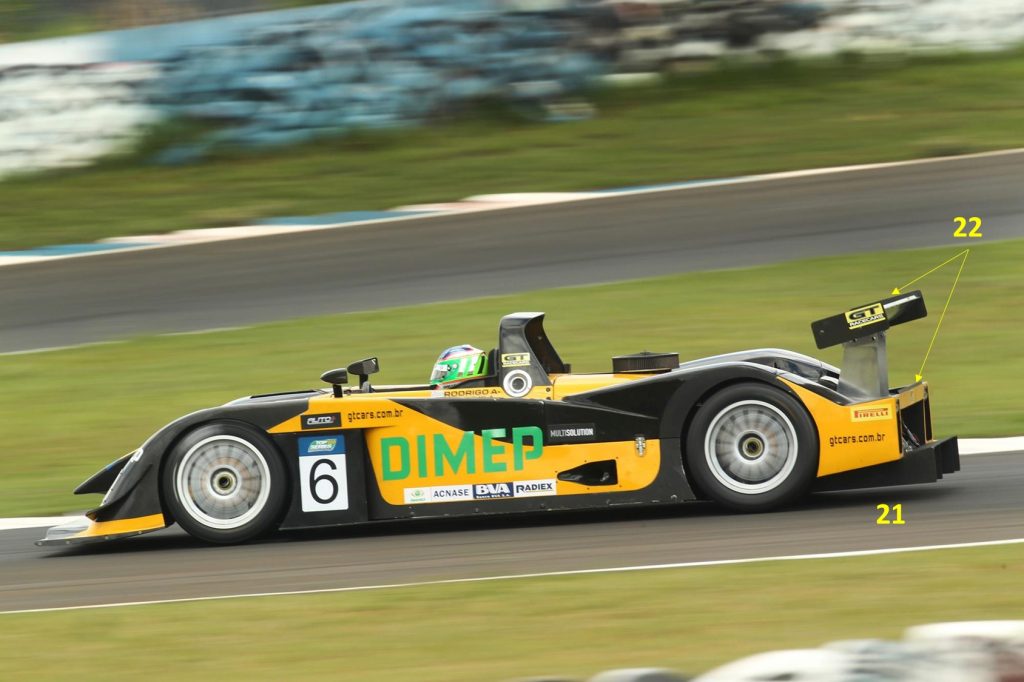
For the fourth round, raced at the tight Londrina circuit, the front fender louvres were completely removed (23), with venting now achieved with large Big Honking Holes (BHHs) similar to what had been used in Le Mans.
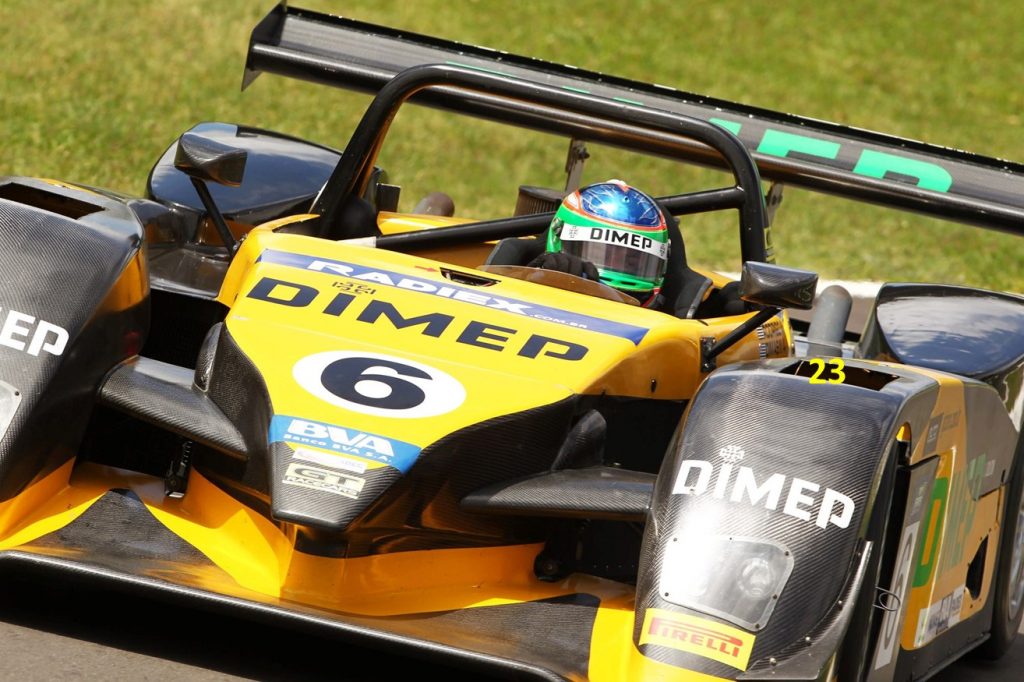
After the 2018 revival, the only major aero modification was the removal of the rear diffuser, used only during the first shake down driven by Ney Faustini.

Results

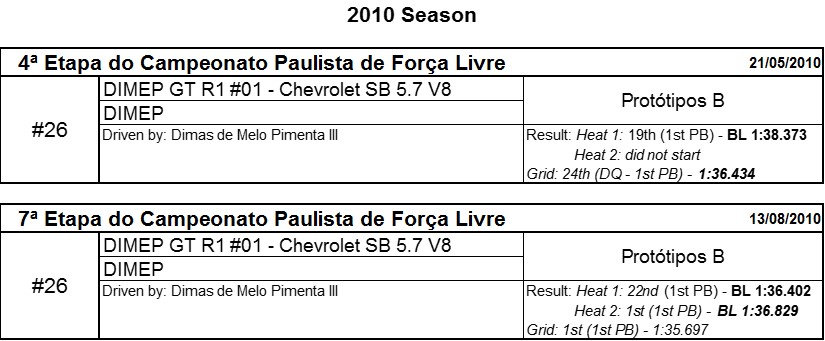
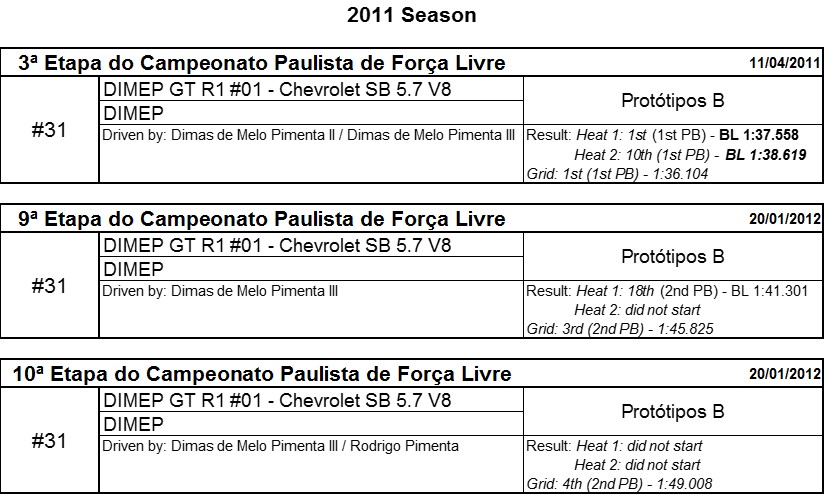
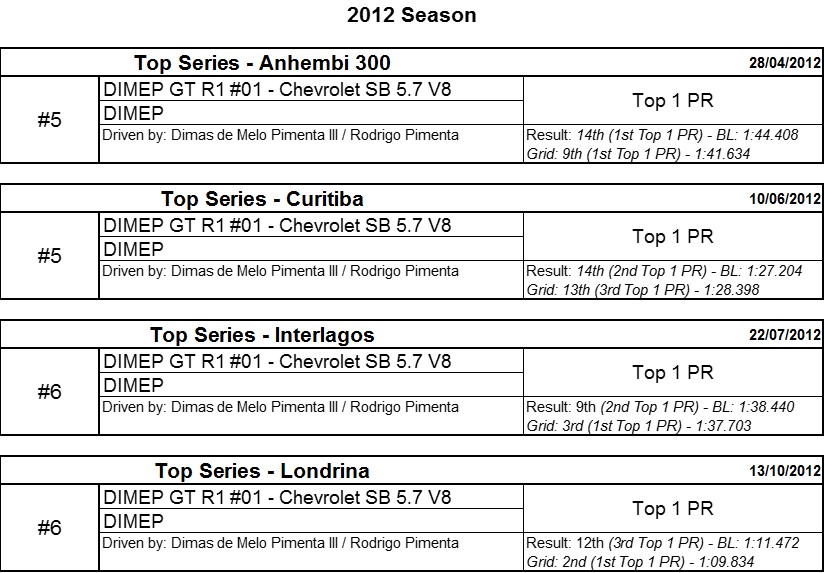
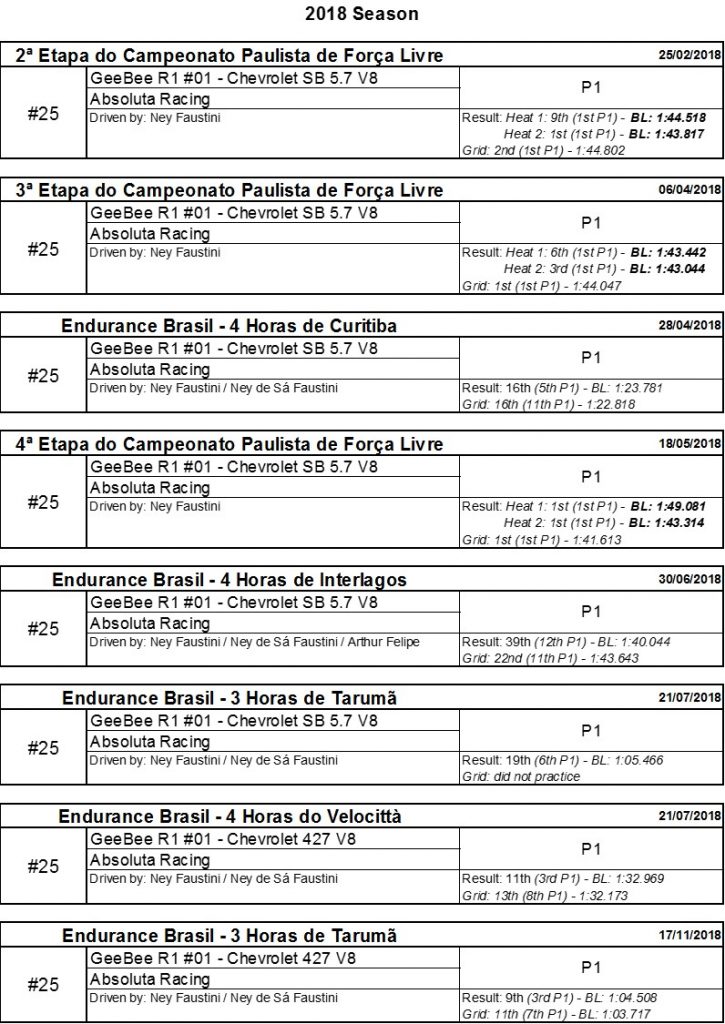

Acknowledgement
I’d like to thank the availability from our friends Jaime Gulinelli and the Faustini Family to share information as well as the images that illustrate this article.
Sources:
JORNALISTAS COMPLETAM DEZ CORRIDAS NO TESTE COM O FIAT MAREA TURBO. Disponível em: http://www.secco.com.br/garrett04.asp?id=272.
1000Km de Brasília: Marea venceu antes da aposentadoria. Disponível em: https://www.f1mania.net/outros/enduro/6441-1000km-de-brasilia-marea-venceu-antes-da-aposentadoria/.
Fiat Brava e Marea Weekend Turbo encaram mais uma prova de endurance: Seis Horas de Curitiba. Disponível em: https://www.inconfidente.com.br/1999.
Conheça nossa História – Em constante evolução, DIMEP comemora os seus 84 anos. Disponível em: https://www.dimep.com.br/historia/,
Avallone-Chevrolet 1993: Disponível em: http://blogdamilmilhas.blogspot.com/2013/03/avallone-chevrolet-1993.html.
Amplamente modificado, o Protótipo Dimep GT R1 correrá em Interlagos na abertura do Paulista. Disponível em: https://www.diariomotorsport.com.br/amplamente-modificado-o-prototipo-dimep-gt-r1-correra-em-interlagos-na-abertura-do-paulista/.
Fittipaldi e Roberto Carlos andam a 220 Km/h e se divertem em São Paulo. Disponível em: http://g1.globo.com/fantastico/noticia/2013/08/fittipaldi-e-roberto-carlos-andam-220-kmh-e-se-divertem-em-sao-paulo.html.
MIL MILHAS BRASIL, INTERLAGOS, 2008 (2). Disponível em: https://www.conexaosaloma.com.br/mil-milhas-brasil-interlagos-2008-2/,
Top Series Endurance. Disponível em: https://www.facebook.com/TopSeriesEndurance/?ref=page_internal.
Com Fittipaldi, Senna e Prost, carros de Le Mans invadem a Av. Paulista. Disponível em: http://globoesporte.globo.com/motor/noticia/2013/08/com-fittipaldi-senna-e-prost-carros-de-le-mans-invadem-av-paulista.html.
Absoluta Racing. Disponível em: https://www.facebook.com/AbsolutaRacing/.
GT Racecars. Disponível em: https://www.facebook.com/GT-Racecars-273758149373188.
Corvette Dimas de Mello Pimenta. Disponível em: http://blogdamilmilhas.blogspot.com/2013/01/corvette-dimas-de-mello-pimenta.html.
Images
[1]: Fiat Marea Weekend nas pistas. Disponível em: http://blogdamilmilhas.blogspot.com/2013/03/fiat-marea-weekend-na-pista.html.
[2]: Avallone-Chevrolet 1993: Disponível em: http://blogdamilmilhas.blogspot.com/2013/03/avallone-chevrolet-1993.html.
[3]: MIL MILHAS BRASIL, INTERLAGOS, 2008 (2). Disponível em: https://www.conexaosaloma.com.br/mil-milhas-brasil-interlagos-2008-2/.
[4]: Paulista de Velocidade – Interlagos – 2ª bat. FL. 14.08.10. Disponível em: https://www.youtube.com/watch?v=7QZZ_EBGGb8.
[5]: Top Series Endurance. Disponível em: https://www.facebook.com/TopSeriesEndurance/?ref=page_internal.
[6]: Com Fittipaldi, Senna e Prost, carros de Le Mans invadem a Av. Paulista. Disponível em: http://globoesporte.globo.com/motor/noticia/2013/08/com-fittipaldi-senna-e-prost-carros-de-le-mans-invadem-av-paulista.html.
[7]: Absoluta Racing. Disponível em: https://www.facebook.com/AbsolutaRacing/.
[8] GT Racecars. Disponível em: https://www.facebook.com/GT-Racecars-273758149373188.
[9]: Corvette Dimas de Mello Pimenta. Disponível em: http://blogdamilmilhas.blogspot.com/2013/01/corvette-dimas-de-mello-pimenta.html.

